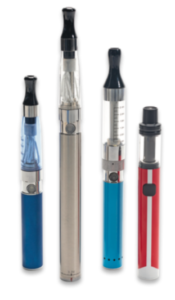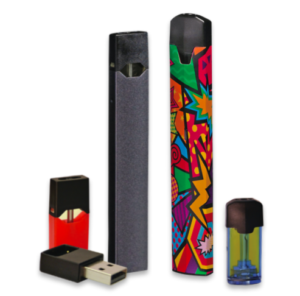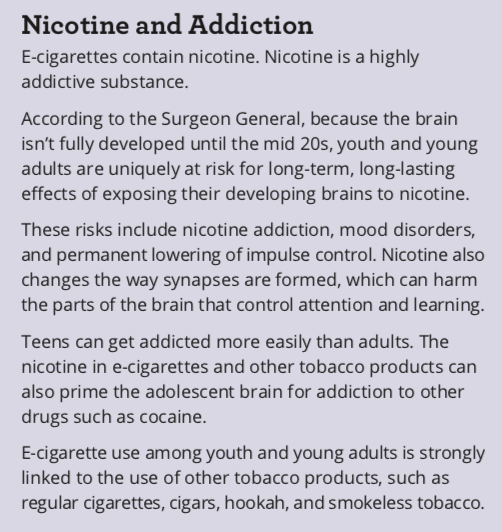Vaping is the act of inhaling and exhaling the aerosol (often called vapor) produced by an e-cigarette or similar battery-powered device.
What is an e-cigarette?
E-cigarettes are battery-powered vaporizers that simulate the action and sensation of smoking.
What are other names for e-cigarettes?
They are also known as e-cigs, vape pens, e-hookahs, e-pipes, tanks, mods, vapes, electronic nicotine delivery systems, or ENDS, and more. Some people refer to vaping devices by their brand names such as JUUL, BO, Blu, and others.
What kinds/types of e-cigarettes are there?
E-cigarettes come in many different sizes, types and colors. Some e-cigarettes are made to look like regular cigarettes, cigars, or pipes. Some resemble pens, small electronic devices such as USB sticks, and other everyday items. The products that are designed to resemble small electronic devices are often compact and allow for discreet carrying and use—at home, in school hallways and bathrooms, and even in classrooms.
What is in e-cigarettes? My child says it’s simply flavored water, what’s so bad about it?
E-cigarettes contain pre-filled pods or e-liquids/e-juices the user adds to the device. E-liquids generally consist of propylene glycol, glycerin, water, nicotine, and flavorings. Many of these pods and e-liquids come in fruit and candy flavors that appeal to youth.
E-cigarettes produce an aerosol, commonly called vapor, which users inhale from the device and exhale. The aerosol can contain harmful and potentially harmful substances, including:
- Nicotine
- Ultrafine particles that can be inhaled deep into the lungs
- Flavoring such as diacetyl, a chemical linked to a serious lung disease
- Volatile organic compounds
- Cancer-causing chemicals
- Heavy metals such as nickel, tin, and lead
The Food and Drug Administration’s (FDA) Center for Tobacco Products has the authority to regulate the manufacture, import, packaging, labeling, advertising, promotion, sale, and distribution of electronic nicotine delivery systems. The FDA does not have authority to regulate vaping accessories.
Many of the FDA’s current enforcement activities are focused on the sale of e-cigarettes to minors both in stores and online, and holding manufacturers accountable for making products so appealing to youth. The FDA has delayed using its regulatory authority over other areas of e-cigarettes, including the manufacture of e-liquids. Without manufacturing regulations, people can’t be sure what is in these products.
Are e-cigarettes safe?
According to the Centers for Disease Control and Prevention, e-cigarettes are not safe for youth, young adults, pregnant women, or adults who do not currently use tobacco products. E-cigarettes have the potential to benefit adult smokers who are not pregnant if used as a complete substitute for regular cigarettes and other smoked tobacco products, but they have not been approved by the Food and Drug Administration as a smoking cessation device. Additional research is needed to help understand the long-term health effects of e-cigarette use.
In addition to nicotine, e-cigarettes contain harmful and potentially harmful chemicals such as ultrafine particles that can be inhaled deep into the lungs; flavoring such diacetyl, a chemical linked to a serious lung disease; volatile organic compounds such as benzene, which is found in car exhaust; and heavy metals, such as nickel, tin, and lead. Due to nicotine content, e-liquids are dangerous to small children and pets. The Massachusetts Attorney General requires that nicotine liquid and gel be sold inappropriate child-resistant packaging. Defective e-cigarette batteries have caused fires and explosions, some of which have resulted in serious injuries.
E-cigarettes and other vaping devices can be used to vape other substances, such as marijuana.
Is being around secondhand vape safe?
No. According to the Surgeon General, the aerosol from e-cigarettes is not harmless. It can contain harmful and potentially harmful chemicals, including nicotine; ultrafine particles that can be inhaled deep into the lungs; flavoring such diacetyl, a chemical linked to a serious lung disease; volatile organic compounds such as benzene, which is found in car exhaust; and heavy metals, such as nickel, tin, and lead.
Scientists are still working to understand more fully the health effects and harmful doses of e-cigarette contents when they are heated and turned into an aerosol, both for users who inhale from a device and for those who are exposed to the aerosol secondhand.
Can e-cigarettes be used to vape other substances?
Yes. E-cigarettes and other vaping devices can be used to vape other substances, such as marijuana. Open systems require the user to add the e-juice, which can be a substance other than nicotine. Closed systems (those that use pre-filled pods) can also be altered to vape substances other than nicotine.
Where are e-cigarettes sold and how are youth getting them?
E-cigarettes are sold in many places including convenience stores, corner stores, gas stations, vape shops, and online. Stores should  ask for identification (ID) of anyone who appears to be under 27 and refuse a sale to anyone who does not present ID or who is under the legal sales age. Online retailers are required to ask for age verification.
ask for identification (ID) of anyone who appears to be under 27 and refuse a sale to anyone who does not present ID or who is under the legal sales age. Online retailers are required to ask for age verification.
Just like other tobacco and nicotine products, youth may get e-cigarettes from many sources. Youth who use these devices may not purchase them directly from a retailer; they may have access to e-cigarettes through friends who vape or from online stores that accept gift cards, for example.
 What can I do to prevent my child from vaping?
What can I do to prevent my child from vaping?
Simply talking with your child about these products can help protect them. Let them know that you care about them and think vaping is not safe.
How can I tell if my child is vaping?
Many types of e-cigarettes are made to resemble everyday items and can easily fit in a pocket or the palm of a hand. In addition, they come in fruit and candy-like flavors. For these reasons, it may be hard to tell if your child is vaping—you may not recognize a vaping device or an e-liquid scent.
Here are subtle signs your child might be vaping:
Unexplained Sweet Scent—If you notice a sweet scent that is unexplainable, it might be a flavored e-juice for a vaping device.
Unfamiliar Products—If you come across unusual looking items such as unusual pens or USB drives or an unfamiliar battery or battery charging device, they could be associated with vaping. The best way to know is to educate yourself about the products and to talk with your kids.
For information and tips, visit Getoutraged.org
What if my child is vaping—how can I help him/her quit?
Talk with your child’s health care provider about specific resources for teens that address tobacco/nicotine addiction.
Smokefree Teen is a website from the U.S. Department of Health and Human Services geared toward helping teens quit tobacco/nicotine.
Visit teen.smokefree.gov
What if I use(d) tobacco?
Be honest and talk with your child about your choices and how hard it is/was to quit. If you need help quitting tobacco, it’s never too late to keep trying.
Call 1-800-QUIT-NOW or visit makesmokinghistory.org for information and support.
Information is taken from E-Cigarette Use Among Youth and Young Adults: A Report of the Surgeon General, 2016, and the Centers for Disease Control and Prevention (website on Electronic Cigarettes https://www.cdc.gov/tobacco/basic_information/e-cigarettes/index.htm Accessed 5/22/18)
Other sources include:
McRobbie, Hayden; Bullen, Chris; Hartmann-Boyce, Jamie; Hajek, Peter (2014). “Electronic cigarettes for smoking cessation and reduction”. The Cochrane Library. 12: CD010216. doi:10.1002/14651858.CD010216.pub2. PMID 25515689.
Is My Child Vaping? (2018, February 19). Retrieved from https://raisingteenstoday.com/is-my-child-vaping-heres-9-signs-to-watch-for/. Accessed 5/18/18





